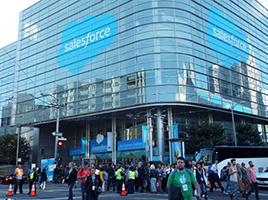While many of us are busy covering the new bright shiny object that is AI and machine learning, a quiet revolution in healthcare, one of IT’s oldest venues, might be taking place. Interestingly it may be following the same course now spotlighted in the great ERP migration to the cloud.

Many long term followers of cloud computing’s progress can easily recall the conventional wisdom from a decade ago that while front office operations might move their data and processes to the cloud, there was simply no way that an enterprise would ever trust its back office financials to cloud providers. Today cloud ERP is a happening thing and while there are certainly legions of enterprises still set against the idea, many are taking the plunge.
Companies like cloud ERP provider, NetSuite—the object of a recent $9.3 billion offer from Oracle—Financial Force, IntAcct, various accounting products from Microsoft, SAP, Oracle and many others all give proof points that the ERP migration to the cloud is ongoing. The trick that made a trickle that eventually caused a tsunami, is two-fold: a need to economize on systems and a strategy of surrounding legacy systems with more nimble and easier to maintain cloud systems. The strategy gave enterprises the opportunity to expand the back office footprint without the harrowing exercise (and expense) that brought those systems into being before the date change orgy at turn of the last century.
Step two will be what happens when the CIO and CEO decide that the legacy ERP systems can be squeezed out with resulting significant economies. Certainly a company like Oracle buying a company like NetSuite sets the wheels in motion.
Now a similar strategy, roughly a decade behind ERP by my estimate, awaits healthcare software. Not the systems that manage medical billing and payments, which have been on a more consistent footing for many years. But the clinical systems that capture data from auto analyzers; manage laboratories and admissions, discharges, and transfers; schedule operating rooms; and especially those that capture electronic medical records, are ripe for disruption.
Together these systems capture and manage the vital information about patients, the core purpose of any healthcare operation. Since the 1960’s healthcare systems have been built in a technology completely different from what’s used in business software. Where enterprises have used relational databases and a succession of languages like C++, HTML, and Java, healthcare applications have been written in Mumps or its derivatives. Pioneered at Massachusetts General Hospital in the late 1960s, Mumps was an approach that gave users the ability to craft their systems for mini-computers and later for Unix machines.
But the technology developed so differently from other software technologies that today its systems, and importantly its data, represent one of the true walled gardens of the software world. Exchanging data and integrating processes between Mumps and non-Mumps systems requires significant effort with a resulting bias for more Mumps rather than less whenever decisions about new systems need to be made.
As a walled garden Mumps requires programming hard to find specialists who can code applications and write reports and while they are good at what they do, new technology advances often have to be reinvented in Mumps rather than absorbed from the general industry.
As is often the case, walled gardens create oligopolies, small groups of vendors that control the market and set prices to their advantage. For instance, if a single airline serves a city it has an effective monopoly on one or several routes and sets pricing accordingly. If there are two or more airlines, the effect can become an oligopoly. While it’s illegal in most places for the oligopolists to collude in setting prices, they can effectively communicate through the marketplace by publishing their ticket prices, schedules, and non-monetary offers. So the effect is the collusion we guard against in law.
In healthcare a kind of oligopoly exists and though perfectly legal, it is a contributing factor to the high costs of healthcare. For instance, the leading provider of electronic medical records systems, is Epic Systems. Epic was founded in 1979, in Madison Wisconsin by Judith Faulkner and is privately held. It is now located on a 950 acre campus in Verona, WI and Faulkner remains the CEO.
Epic bases its electronic health records on Cache, a Mumps database produced by InterSystems of Cambridge, MA. According to a 2014 story by Helen Gregg on the site, Becker’s Hospital Review, Ten Things to Know About Epic,
Some of the nation’s largest and most prestigious hospitals and health systems use Epic’s EHR system, including Oakland, Calif.-based Kaiser Permanente, Cleveland Clinic, Johns Hopkins Medicine in Baltimore, UCLA Health in Los Angeles, Arlington-based Texas Health Resources, Massachusetts General Hospital in Boston, Mount Sinai Health System in New York City and Duke University Health System in Raleigh, N.C.
The only problem for healthcare providers is that Epic is very expensive to buy and operate. According to Gregg,
Epic EHR systems are some of the most expensive on the market. Duke University Health System reportedly paid $700 million for its Epic system; Kaiser Permanente, $4 billion. Additionally, a Peer60 survey found Epic EHRs come with higher upgrade costs — Epic users spent an additional sum between 40 and 49 percent of the system’s initial costs in major and minor upgrades, while Cerner users spent between 30 and 35 percent and Allscripts users spent between 20 and 22 percent.
Such costs are major drains on any healthcare system. This might be exactly what to expect from an oligopoly (InterSystems products underlie Epic’s) but what’s stunning is how expensive this rudimentary storage and retrieval system can be. This looks like an industry ripe for disruption.
But there are indications that the surround strategy that is so effective in ERP will next be felt in healthcare. Healthcare has been one of Salesforce’s significant areas of interest for several years. We’ve seen videos of one off success stories at UCSF medical center but the company has continued to make inroads in clinical settings with its cloud computing and platform infrastructure.
The healthcare systems on display at Dreamforce all share the characteristics of leveraging cloud computing and a modified CRM data model to produce satellite systems that can interact with traditional MUMPS systems. Where the traditional systems mainly focus on acute care and making people well in a hospital setting, the cloud systems focus on the clinics and outreach to patients in their homes to help patients stay on their protocols, such as ensuring that they take their medicines on time thus enabling healthcare professionals to keep tabs on patients and keep them well. Almost anything you could imagine a patient needing could be accessed by these cloud systems. Keeping the health data in the cloud instantly makes it more accessible and therefore useful.
Further, it’s not just Salesforce nibbling on this opportunity, so is Apple. This summer, Tim Cook, Apple CEO, said the company is investigating ways to give consumers ways to save and manage their health records rather than leave it to the large provider organizations. Said Cook,
Unhappiness with EHR technology has led consumer advocates and health IT advocates to push for personal health recordkeeping. The construction of a consumer product that aggregated patient health and fitness data, and offered nudges when appropriate, would fulfill many fond wishes from policymakers.
The change in emphasis to wellness over recovery helps ensure patients can stay out of the hospital, live healthier lives, and significantly, spend fewer healthcare dollars, or perhaps spend them more effectively. With a Salesforce orientation, doctors are better able to track their patients, insurance companies have more effective approaches to cost containment, and researchers have modern databases on which, with appropriate permissions, they might be able to conduct studies to determine treatment efficacy as never before. Thus Mumps and healthcare may be ripe for disruption and we might be seeing the beginning of it.
Author: Denis Pombriant






